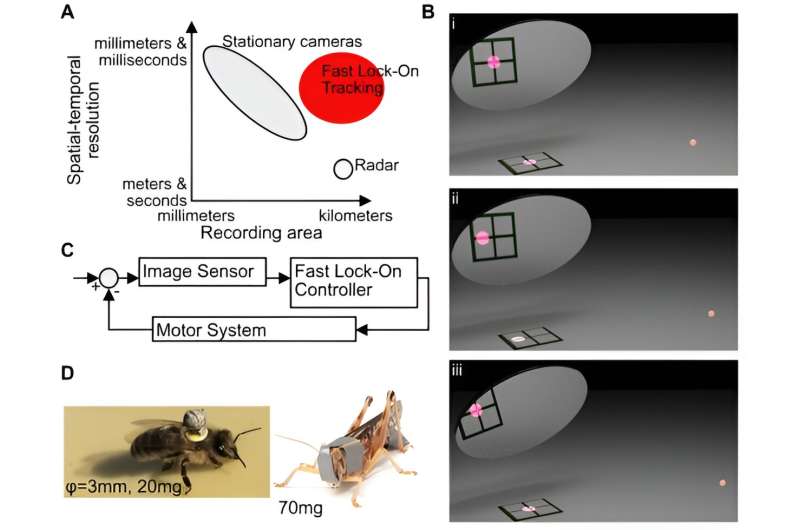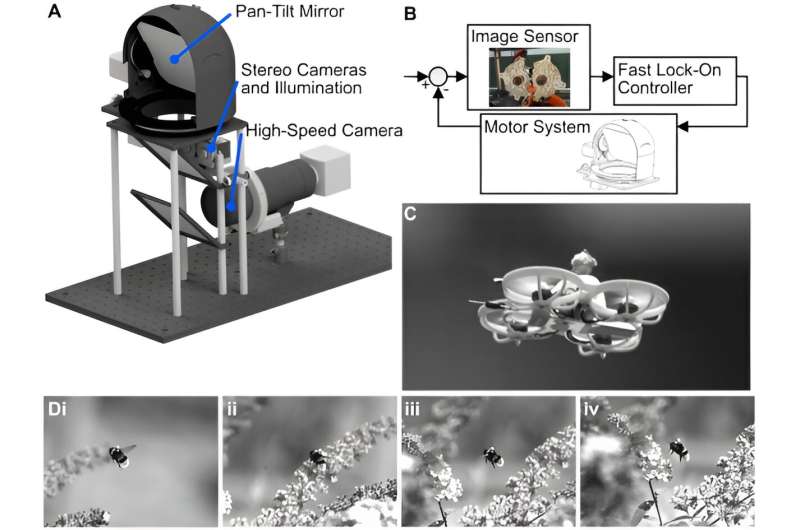January 2, 2024 feature
This article has been reviewed according to Science X's editorial process and policies. Editors have highlighted the following attributes while ensuring the content's credibility:
fact-checked
preprint
trusted source
proofread
New high-speed video system uses sensors, infrared illumination to track insects in large wild areas

Our ability to learn more about insect behavior—which affects ecology, health, and economy on a global scale—depends largely on suitable recording technology. But until now, these tools have been considerably limited.
To address this issue, a research team from Albert-Ludwigs-Universität Freiburg in Germany has developed an adaptable system that can be combined with various types of hardware to produce high-speed video recordings of insects' flight behavior and to track, over significant distances, their trajectories in the wild.
The team describes this technology in a paper titled "High Resolution Outdoor Videography of Insects Using Fast Lock-On Tracking," published on the bioRxiv preprint server. This new work is a follow-up to their earlier research on this topic, published in 2020.
Existing recording methods and their limitations
Historically, insect behavior researchers have relied on direct observation to gain new insights, and more recently they have employed harmonic radar tracking for information about insect flight trajectories, especially those of bees. The resolution of this type of radar, however, is limited both spatially and temporally.
Within laboratories, researchers have used higher-resolution cameras to study details of insect flight behavior, but the usefulness of such cameras does not extend to natural insect environments, where any number of variables may play into flight function.
Researchers have also used stationary camera videography (in which the camera can automatically follow subjects' movement) with some success, but this method is most effectively used with a limited number of pixels for a specific field width. Applying this method to a wider field yields lower angular resolution, while adding pixels blurs subject motion. Magnifying the subject while manually continuously adjusting the camera's aim to follow movement has not been possible.
Meanwhile, combining high-magnification optics with high-speed image tracking works with larger subjects such as birds, drones, and sports balls, but low latency is needed for small subjects like insects. Surrounding flying insects with multiple cameras or using simplified backgrounds in indoor settings might help, but these methods also carry obvious limitations.
However, retroreflectors represent a potential solution for effective, detailed insect tracking. Informed by studies using a previously developed method to track insects, the research team behind this newest work has dubbed the solution Fast Lock-On (FLO) tracking and reports on their efforts to use it to track outdoor insect flight.
FLO tracking with insects
To use FLO tracking with flying insects, a tiny, lightweight retroreflective marker is affixed to a subject. As the subject moves, the marker sends a signal to an optical sensor, steering the sensor's optical axis while minimizing the subject's divergence from the central point of the sensor. In this study, the researchers built in infrared illumination close to the sensor's optical axis, and panned and tilted the optical axis to recreate the flight paths of their test subjects—including locusts (Schistocerca gregaria), bumble bees (Bombus terrestris) and honey bees (Apis mellifera)—via angles detected by the FLO system.
As their paper explains, "Low latency from sensor input to motor output will improve system performance and enable higher magnification optics, which in term can lead to further performance gains. From a control perspective, FLO is a closed-loop design in which the displacement of the target image from the sensor center is an error angle between the insect angle and the angular position of the optical path under control."
The team's testing videos successfully captured test subject flight "from takeoff to landing with high magnification and low motion blur," and insect appendages remained in focus during flight.
Furthermore, the system is not expensive to create, and can be simply built with a computer, a low-latency digital camera, and a pan-tilt motor system. The paper describes hardware, calculations for angle reconstructions, and implementation methods in detail.

System improvement opportunities
The team acknowledges that tracking insect flight outdoors is an important issue that still lacks full resolution. At least three major weaknesses remain. First, a momentary loss of tracking within the FLO closed-loop system could lead to a complete failure to track.
Additionally, "the system does not directly estimate distance to the subject," the paper states. Finally, while precise calibration is not needed for a successful tracking process itself, extracting and accurately determining final 3D coordinates will require such.
Suggested improvements include using multiple FLO systems working together for improved calculation via triangulation, and eliminating the need for retroreflectors through developing advanced computer vision techniques for detecting objects on insects.
However, the researchers remain optimistic that FLO tracking could be used to study numerous aspects of insect flight behavior, including several that relate directly to larger ecological issues, such as insects' responses to artificial nighttime lights, loss of their habitats, and pesticide treatments in their foraging areas.
More information: T. Thang Vo-Doan et al, High Resolution Outdoor Videography of Insects Using Fast Lock-On Tracking, bioRxiv (2023). DOI: 10.1101/2023.12.20.572558
Journal information: bioRxiv
© 2024 Science X Network



















